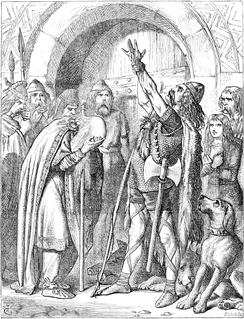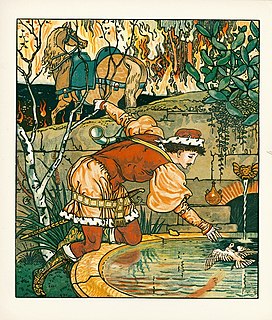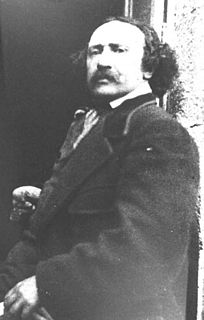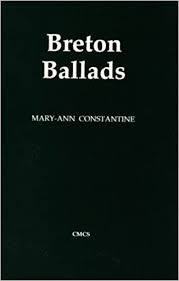
Denez Prigent is a Breton folk singer-songwriter of the gwerz and kan ha diskan styles of Breton music. From his debut at the age of 16, he was known for singing traditional songs a cappella, and has moved on to singing his own songs with techno music accompaniments. He has performed in France as well as internationally and has recorded seven studio and two live albums.

Barzaz Breiz is a collection of Breton popular songs collected by Théodore Hersart de la Villemarqué and published in 1839. It was compiled from oral tradition and preserves traditional folk tales, legends and music. Hersart de la Villemarqué grew up in the manor of Plessix in Nizon, near Pont-Aven, and was half Breton himself.

The Franciscan Missionaries of Mary are a Roman Catholic religious institute founded by Mother Mary of the Passion at Ootacamund, then British India, in 1877. The Missionaries form an international religious congregation of women representing 79 nationalities spread over 74 countries on five continents.
"The Cruel Mother" is a murder ballad originating in England that has since become popular throughout the wider English-speaking world.
"Hind Etin" is a folk ballad existing in several variants.
Fair Annie is Child ballad number 62, existing in several variants.
The Sacrament of Penance is one of the seven sacraments of the Catholic Church, in which the faithful are absolved from sins committed after baptism and reconciled with the Christian community. While in current practice reconciliation services may be used to bring out the communal nature of the sacrament, mortal sins must be confessed and venial sins may be confessed for devotional reasons. According to the current doctrine and practice of the church, only those ordained as priests may grant absolution.

Princess Belle-Etoile is a French literary fairy tale written by Madame d'Aulnoy. Her source for the tale was Ancilotto, King of Provino, by Giovanni Francesco Straparola.
"The Maid and the Palmer" is an English language murder ballad with supernatural/religious overtones. Because of its dark and sinister lyrics, the song was often avoided by folk singers. Child's main text comes from the seventeenth century ballad collection compiled by Thomas Percy, supplemented by a nineteenth century fragment recalled by Sir Walter Scott, although scholars believe that the original English language version of the ballad is considerably older, and derives from a Continental original dealing with a medieval legend associated with Mary Magdalene. The ballad was present in oral tradition in Scotland in the early years of the nineteenth century but was subsequently lost there, however versions have since been recovered in Ireland, in particular among the Irish Traveller community, with an intervening gap of some 150 years. A small fragment of the ballad has also been claimed to have been recovered in the U.S.A., but the veracity of this record is disputed.
Morgens, morgans, or mari-morgans are Welsh and Breton water spirits that drown men.
Fair Mary of Wallington or Fair Lady of Wallington is Child ballad 91 and number 59 in the Roud Folk Song Index. Child lists at least seven variants of the ballad. The first variant is titled "Fair Mary of Wallington", while another variant is titled "The Bonny Early of Livingston".

"I Don't Know How to Love Him" is a song from the 1970 album and 1971 rock opera Jesus Christ Superstar written by Andrew Lloyd Webber (music) and Tim Rice (lyrics), a torch ballad sung by the character of Mary Magdalene. In the opera she is presented as bearing an unrequited love for the title character. The song has been much recorded, with "I Don't Know How to Love Him" being one of the rare songs to have had two concurrent recordings reach the Top 40 of the Hot 100 chart in Billboard magazine, specifically those by Helen Reddy and Yvonne Elliman, since the 1950s when multi-version chartings were common.

François-Marie Luzel, often known by his Breton name Fañch an Uhel, was a French folklorist and Breton-language poet.
Françoise Morvan is a French writer who specialises in Breton history and culture.

Absolution of the dead is a prayer for or a declaration of absolution of a dead person's sins that takes place at the person's religious funeral.

A groac'h is a kind of Breton water-fairy. Seen in various forms, often by night, many are old, similar to ogres and witches, sometimes with walrus teeth. Supposed to live in caverns, under the beach and under the sea, the groac'h has power over the forces of nature and can change its shape. It is mainly known as a malevolent figure, largely because of Émile Souvestre's story La Groac'h de l'île du Lok, in which the fairy seduces men, changes them into fish and serves them as meals to her guests, on one of the Glénan Islands. Other tales present them as old solitary fairies who can overwhelm with gifts the humans who visit them.
"Gwerz Skolan" is a gwerz with a long tradition in Lower Brittany, especially Léon-Trégor and Cornouaille. Its story is found in Old Welsh texts also, and the oldest extant Welsh version is found in the 13th-century Black Book of Carmarthen. The poem is cited as evidence for the preservation in Brittany of cultural memories and traditions predating the entrance of Bretons into Brittany. The gwerz was performed in Brittany until the 19th century, with some late examples from the 20th century. Its content describes a man who had died after living a life of rape and murder, and now comes back from hell to ask for forgiveness.
The Gwerz Santes Enori is a Breton gwerz, a type of folk song that combines literary with musical characteristics. The song, which is preserved in many versions and fragments, tells a story that resembles a saint's life, a 14th-century version of the hagiography of the Breton saint Budoc. Its general theme has been called that of "the girl with a golden breast", as told in stories throughout the Celtic world and surviving in oral form into the 20th century.

Breton Ballads is an academic monograph by Mary-Ann Constantine, published in 1996. The book includes examples of the Breton ballad known as the gwerz, and follows their history, and that of scholarship on the genre, into the 19th and 20th centuries. It was awarded the Katharine Briggs Prize by The Folklore Society in 1996.
An Dialog etre Arzur Roe d'an Bretounet ha Guynglaff is an anonymous poem in 247 lines relating the apocalyptic prophecies which King Arthur extracted from one Guynglaff, a wild man, prophet and magician closely analogous to Merlin in the earliest Welsh tradition. It dates from about the middle of the 15th century, making it the oldest surviving work of literature in the Breton language.









